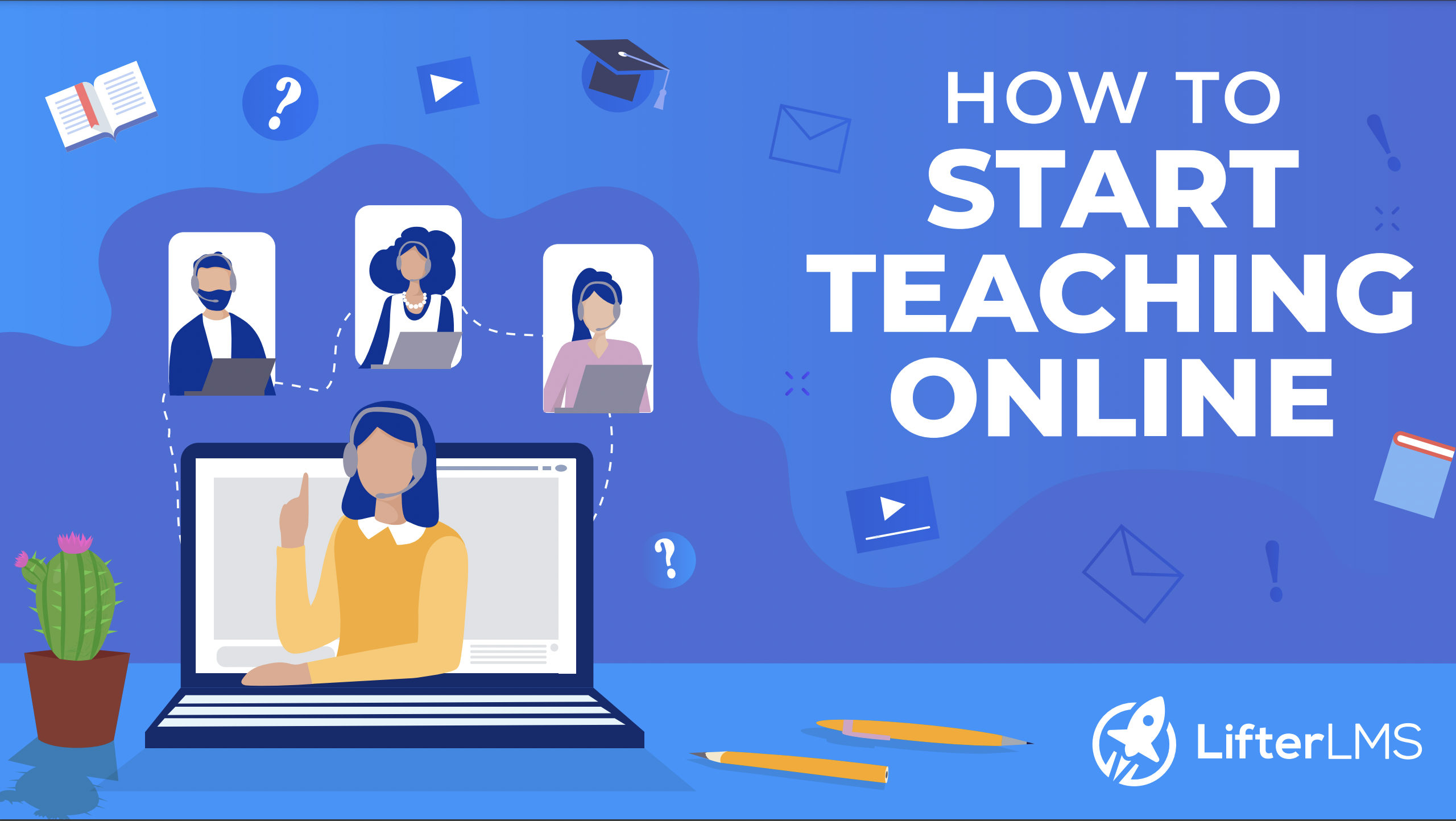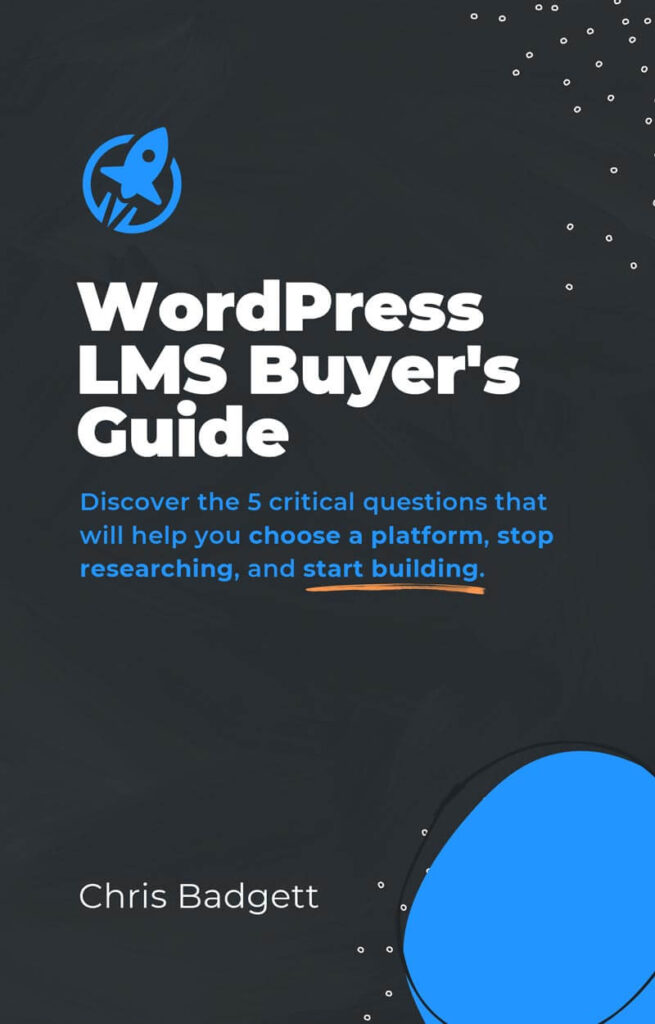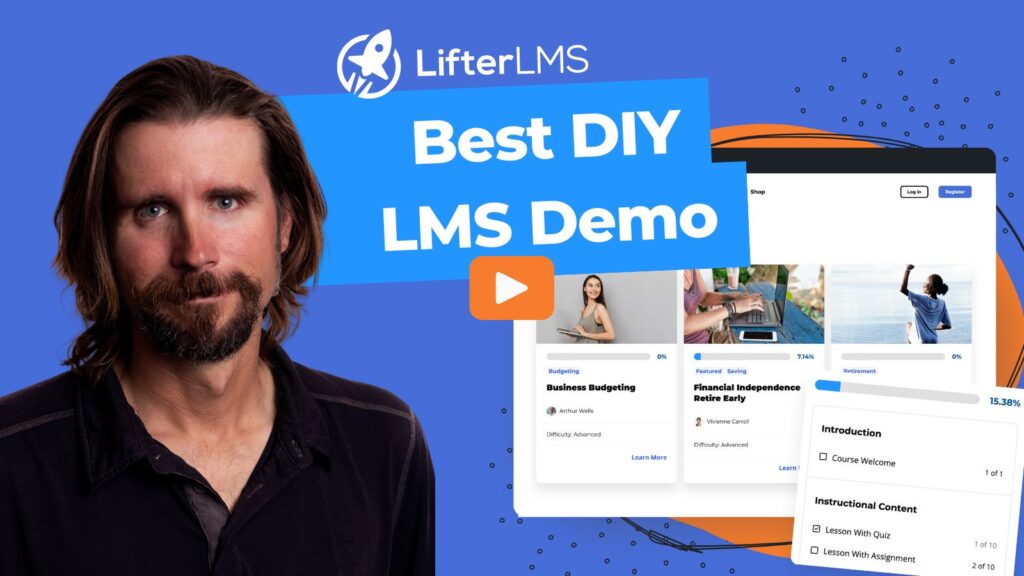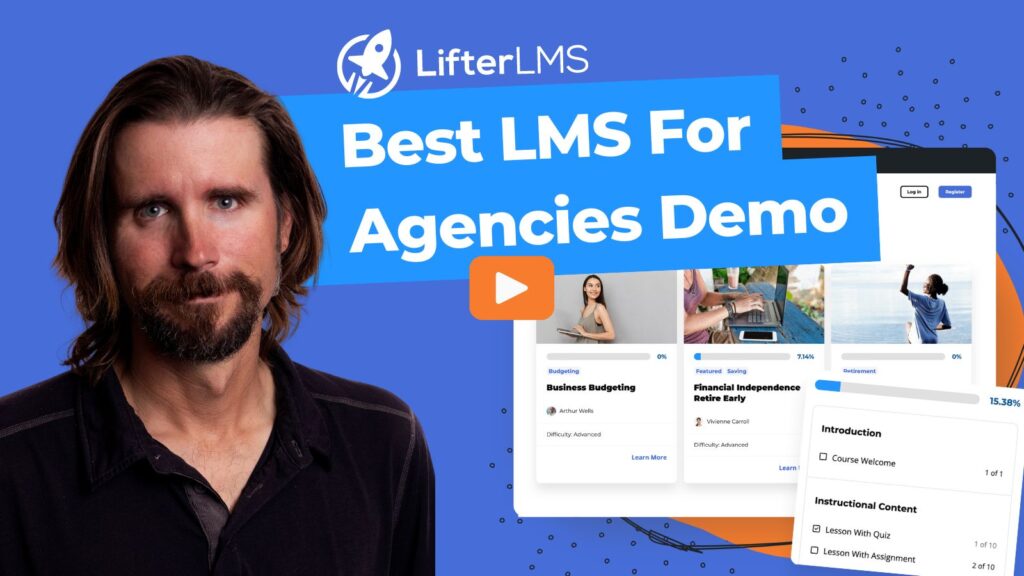This post will tell you the entire teaching process online in short words. Some of you might even think that we’re trying to over-simplify it. But that’s the target! LifterLMS evolved a lot, and now we serve users from all walks of life. We even offered done-for-you service for a while. In addition, we now have an experts program where you have options for a wide range of developers and agencies that help you start an eLearning platform within a few days!
Let’s jump on to the basics to understand some concepts and answer some commonly asked questions for beginners.
What is Online Teaching?
For starters, it’s the same as teaching in a classroom, but students will not be sitting in front of you. In addition, they will not interact with you in real life because they will be watching the lectures in video format, just like you watch TV.
The students will send you their questions via the Q&A feature or some messaging or communication feature you enable in your platform. The students can also submit their assignments and quiz tests in most online teaching solutions.
What Do I Need to Start Teaching Online?
You can start uploading your lesson contents to a hosted website like Udemy, Teachable, Coursera etc. But considering the amount of money you get in hand from the course sales after paying everything for the platform, we are not going that way.
Having data privacy, control over features, and customizability, we will discuss the hard way of having your own platform where you have control over every single thing. Besides, when you build something from scratch and customize it your own way, it is more valuable to you and you will always feel encouraged and motivated to work more with it. Don’t take my word for it; try googling “the ikea effect” and you will get all the resources behind this theory.
The requirement is simple as running a website. You will need-
- A web hosting to install and store the teaching system along with videos, images, audio, or other resources.
- A domain name so that students can find your platform easily.
- An online teaching solution or software to manage all learning materials and student data.
These 3 are basic materials that you need to teach online. You need to prepare the text and images for the landing pages. For example- you need to have a proper website with home, about, contact, and privacy policy pages.
Most smartphones these days have HD video recording and it’s enough to record video lessons. I am assuming that you already have a smartphone. If you want to take things further and offer premium quality video and target a premium price tag like $1500 or above for a course, then you can hire a team of film crews to shoot Masterclass quality videos with professional lighting, cinematography, and post-processing facilities.
Investing in a good microphone is always a good idea. If you’re just starting out, then you can buy a cheap lavalier microphone that can be attached to your clothing to keep it close to your mouth. This will help you get clear audio and you can always connect it to your smartphone or computer.
If you’re going to teach something traditional like Physics, Math, etc. then having a whiteboard is helpful to draw certain figures and explain everything. But for business coaching or some kind of knowledge sharing, screen capturing is a better idea. In that way, you can record your screen while playing a PowerPoint or Google Slide. And for lifestyle courses like Yoga, Cooking, and Gardening, just a smartphone and a microphone are enough.
I am not going into very fine details of the professional grade course building process with a 10-20 people team to manage everything as this post is intended for beginners. So, I am keeping the suggestions and ideas as simple as possible so as not to scare everyone away 😃
What Skills are Required to Teach Online?
Clear Pronunciation: I consider this very crucial because people get attracted to good voices with crisp pronunciation a lot. It helps everyone to understand the speech easily even if they are not native speakers. Sometimes, you need to generate subtitles and lesson transcripts using an AI tool. That too needs the best quality of voice to spell every word correctly. This will save you time in the long run.
Presentation Skills: If you’re already a professional teacher and taking classes in real life, then you already know the importance of dressing sense, body language, eye contact, and other essential topics to focus on. As most of the video-based courses tend to be pre-recorded and do not get updated very frequently, you would definitely want to look for your best version. Even investing a little bit in makeup wouldn’t hurt.
Proper Plan and Script: The lessons should always be planned at least 2-3 days before and rehearsed at least twice to understand if everything is being covered properly and it is digestible by the students. If you try recording on the fly, you might end up wasting a lot of time taking numerous shots and the course might never see the light! Having a script also saves you from the stress of missing something, going a very long time with a topic, or talking too fast or slow. Because timing is very important and people lose interest very fast these days. So, we will have to plan to make things as short as possible keeping all the essential parts of the lesson intact. I personally believe that can not be done on the fly.
We can definitely take some time to think about things in real-life classes but things are different when people are learning on a device. Because there is a very high scope of distraction. So, we have to plan our best to keep them engaged and keep things as much interesting as possible.
Some Software Skills: As you’re reading this post on a certain device, I believe you already have that but there is a little bit more. You might need to cut and remove some blanks from a recorded video and add the audio later if you’re recording in a noisy place. These can be done with some basic software skills with iMovie or Premier Pro and most other video editing software. YouTube has plenty of tutorials on these topics. Please watch them before you start recording.
You might need some skills with word processing and WordPress to create courses, upload content, review assignments, quiz attempts and communicate with students
How Much Money Needs to be Invested to Start Teaching Online?
If you choose LifterLMS, you can start just by purchasing a domain and shared hosting only. Reliable shared hosting costs on average $35 a year and a .com domain should cost you around $10 a year. So, 45 US Dollars is a good budget to start with given that you already have a computer or a smartphone. Cheap lavalier microphones cost around $30 dollars. If you’re a Mac user, you will get iMovie editor for free. You can cut, copy and paste audio tracks in iMovie as well. I have not used windows much, so, I am unable to offer a good video editing software suggestion. I have heard good things about DaVinci Resolve. Audacity is a good free software for audio editing and is available on all platforms.
OSX has built-in screen capturing support. There are some Chrome extensions that also offer screen capturing features free of cost.
Starting a Marketplace or Single instructor is Better?
This depends on your business plan and current situation. Two is always better than one in this case. If you can convince a couple of friends to start teaching online with you, then you can distribute some of the tasks among yourselves and also amplify the marketing channels through your circles, social media, and other places you know.
Having ideas for future expansion is great but a marketplace is like a monster truck that needs a huge amount of fuel to run. So, if you’re alone, please try starting with one course on the website. Even you can create the domain in your personal name and personal branding. It will save a lot of time and effort. If you already have a name and domain with that name, then there is no problem starting with that.
What are the Hardware and Software Requirements for Online Teaching?
Computer Configuration: 8GB RAM with Core i3 Fifth Generation or higher processor. Better if you have an iMac or MacBook.
Server Configuration: Minimum of 1GB RAM with 5GB space and 50GB Bandwidth per month to start with. When you get some students and the resources are being used at their top capacity, you can increase the configuration gradually. All hosting providers have the option to add more RAM, CPU Core and Storage Space.
If you have the budget and planning for some premium courses, you can definitely consider starting with Amazon Cloud, Google Cloud Platform, Microsoft Azure, or Alibaba Cloud. You can also take content delivery solutions from Cloudflare and similar companies to offer less latency and better accessibility of your content.
Please don’t worry about content security or piracy. Because no one will think of stealing from you unless you have something valuable. So, when you become a brand and have a couple of thousand students, that is the time to think about safety and security.
But I do not mean that you shouldn’t have some minimal measures configured for a rainy day. You can install free plugins like WordFence and Login limit attempt to save your website from some easy attacks.
Software Requirements: You will need to install WordPress and LifterLMS on your server. So, we can consider these two the most crucial pieces of software for your platform. Other pieces like Microsoft Office Suite, Google Docs, Sheets, and Slides are optional because most of the smartphone apps and built-in features help you with a lot of things.
We will work on a separate blog post to share some important software that helps in course creation, maintenance, and quality enhancement. Please join our Facebook group and follow our social media profiles to get notified about the new post on software suggestions with relevant tutorials.
How Much I Can Earn Teaching Online?
Forbes and Inc.com cited research found at Research and Markets where they claimed that the eLearning industry might be worth $350 by 2025. This research was done back in 2019 before the pandemic. You already know how much the industry grew in the past 2 years of the COVID pandemic and also look at the $1.5 billion acquisition of Lynda.com by LinkedIn.
With LifterLMS, people are earning $300,000+ every year and we have a couple of case studies about those. So, it is totally possible to make very good earnings in this industry and live a good life along with some savings. So, it is definitely worth a full-time effort and the freedom of working on your own terms.
We wouldn’t tell you that you will be able to earn this or that amount within this time frame. Because depending on the nice, market demand and the quality of content you develop, the earnings will vary. But the chances of failure are very thin if you try your best with quality and also do something better or unique from what is available in the market.
Do I Need to Know Digital Marketing to Promote My Courses?
There are a few ways you can sell your courses to reach your target audience. One way to market your courses is through online advertising. For example, you can use Google AdWords or Facebook Ads to reach people searching for terms related to your courses.
Another way to market your courses is through email marketing. For example, you can use Mailchimp or Constant Contact to reach people already on your email list. You can also use social media for marketing your courses. For example, you can use Twitter, LinkedIn, or Instagram to reach people interested in what you offer.
Finally, you can use word-of-mouth for marketing your courses. You can tell your friends and family about your courses, and they can say to their friends and family. No matter which method you choose, ensure you put your courses in front of the right people. If you do, you will be sure to increase your course sales.
How Do I Retain My Students?
Online teaching: Things You Should Know Before Tutoring Online.
Online teaching has become one of the most popular after COVID. There are plenty of websites these days with online courses that can teach anyone anything they want to in a short time.
Just like many others, you might think about becoming an online tutor. If so, you need to know a few critical factors that can be a game changer for you. First, even if you are already teaching online, you might need to improve your methods.
Either way, you should know a few things before getting started. In this blog post, we’ll go over some of the most important aspects of online teaching so that you can hit the ground running!
What is online teaching?
Online teaching is a process of delivering education and instruction via the internet. This type of teaching can be done in various ways, including through email, chat, video conferencing, and online courses. Online teaching can be an effective way to deliver education and training to students who are not able to attend traditional in-person classes.
What do I need to teach online?
There are a few things you’ll need to consider when planning to teach online:
-First and foremost, you’ll need to determine what type of class you’ll be teaching. If you’re teaching a course that requires hands-on learning, you’ll need to find a way to replicate that online. If you’re teaching a more theoretical course, you’ll need to find ways to engage your students and keep them interested.
-You’ll also need to consider your students’ different learning styles. Some students may prefer to learn by watching videos, while others may like to read texts or participate in discussions. Find a way to cater to all of your student’s needs.
-Finally, you’ll need to plan for technical difficulties. Things like internet outages and audio/video issues can happen, so it’s essential to have a backup plan. By being prepared, you can ensure that your online class goes smoothly, regardless of any hiccups.
What skills are required to teach online?
You will need to develop a few essential skills to teach online. First and foremost, you need to be able to engage with your students in an online setting. This means effectively communicating with them via chat, email, or video conferencing. Additionally, you need to be able to create engaging and interactive content that will keep your students engaged in the learning process. Finally, you need strong organizational skills to keep track of your student’s progress and assignments. With these skills, you can successfully teach online and provide your students with a great learning experience.
How much money needs to be invested in starting to teach online?
To start teaching online, you must make a few initial investments. First, you must purchase a good-quality webcam and microphone so your students can see and hear you clearly. You will also need to invest in quality course materials, such as ebooks, online lessons, and video tutorials. Finally, you will need to set up a payment system so students can pay you for your services.
While you can get started with a smaller investment, this is the bare minimum that you will need to provide a quality online learning experience for your students.
Starting a marketplace or single instructor is better?
There are many factors to consider when deciding whether to start a marketplace or single instructor business. Some important considerations include:
-What is your budget? Creating a marketplace can be more expensive than starting a single instructor business, as you will need to pay for marketing and website development.
-Who is your target market? A marketplace can be a great option if you have a large and diverse target market, as it will allow customers to choose from various instructors. On the other hand, a single instructor business may be a better option if you have a specific target market in mind.
-What are your business goals? A marketplace may be the best option if your goal is to build a large and successful business. However, suppose you are aiming for a more personal and intimate business. In that case, a single instructor business may be a better fit.
What are the hardware and software requirements for online teaching?
When it comes to online teaching, there are a few hardware and software requirements you’ll need to get started:
- You’ll need a computer with a stable internet connection.
- You’ll need a webcam and microphone to interact with your students in real time.
- You’ll need some essential editing software so you can create engaging and informative lessons.
So, there you have it! These are the hardware and software requirements for online teaching. With these essentials, you’ll be able to start reaching out to students and making a difference in their lives.
How much can I earn teaching online?
The proliferation of online education has created opportunities for educators to reach students worldwide. But how much can you earn teaching online?
Like most things in life, earnings potential for online educators varies widely. Several factors, such as the type of course you’re teaching, your experience, and the platform you’re using, can affect your earnings.
Online courses are less expensive than traditional, in-person courses, so online educators typically earn less per course than their offline counterparts. However, the flexibility and reach of online education mean that you can potentially reach a larger audience than you would offline, which can lead to increased earnings potential.
For example, an experienced online teacher using a popular platform to reach a large audience could earn more than a traditional, offline teacher. Conversely, a less experienced online teacher using a less popular platform to get a smaller audience could make less.
Ultimately, how much you can earn teaching online will depend on several factors. But with the right mix of experience, platform, and audience, you could make a good income from online teaching.
How do I market my courses?
Are you looking to market your courses but don’t know where to start? There are a few ways you can sell your courses to reach your target audience.
One way to market your courses is through online advertising. For example, you can use Google AdWords or Facebook Ads to reach people searching for terms related to your courses.
Another way to market your courses is through email marketing. For example, you can use Mailchimp or Constant Contact to reach people already on your email list.
You can also use social media for marketing your courses. For example, you can use Twitter, LinkedIn, or Instagram to reach people interested in what you offer.
Finally, you can use word-of-mouth for marketing your courses. You can tell your friends and family about your courses, and they can say to their friends and family.
No matter which method you choose, ensure you put your courses in front of the right people. If you do, you will be sure to increase your course sales.
How do I retain my students?
You can do a few key things to retain your students and keep them coming back for more classes:
- Make sure you are providing quality instruction and engaging content. If your students are bored or not learning anything new, they will be less likely to return.
- Be flexible with your schedule and make it easy for students to sign up for classes. If students jump through hoops to register, they will be less likely to continue taking lessons from you.
- Ensure you are responsive to your student’s needs and feedback.
If they feel you are listening to them and taking their suggestions to heart, they will be likelier to stick around.
How can I Upsell and Utilize My Existing Userbase?
If you’re looking to upsell and better utilize your existing user base, there are a few things you can do:
- Make sure you’re providing them with the best possible experience. If they’re happy with your product or service, they’re more likely to want to upgrade to a better version or add on to what they’re already using.
- Offer them discounts or other incentives to upgrade.
- Keep an open line of communication, so they know what new features or products you have to offer.
How Can I Promote My Course Discounts, Sale, and Other Offers?
There are many ways to promote your course discounts, sales, and other offers. You can use social media, email marketing, and even word-of-mouth to get the word out. The most important thing is to ensure that your offers are easily accessible and that your target audience is aware of them.
Optin and WordPress pop-up plugins with exit intent support can also help you promote offers and communicate better with prospects. Optin Monster is a highly recommended solution as well. We ourselves are utilizing it on a couple of websites. It also has the largest amount of active installs in the market.
These are the most commonly asked and discussed questions in our community and customer support tickets and chats. If you have more questions for us, please feel free to post on our Facebook group or tag us on Twitter or use the contact form on our website. We will be happy to assist you and learn from you.






